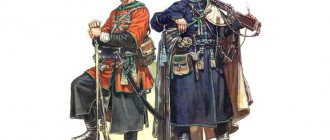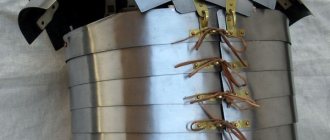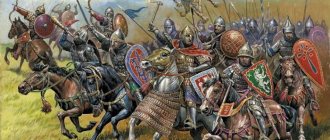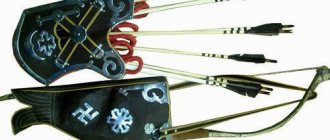Sabers
The attraction to this type of weapon is due to the fact that Poland’s opponents often used elements of light armor made not from armor plates, but from soft materials - fabric, felt, etc. Such protection, with a number of obvious disadvantages (primarily, less defensive quality) has a number of advantages, among which in this case one is fundamental: a straight blade “gets stuck” in it during a chopping blow.
Structure of the Polish saber
The Polish saber, in fact, like any other saber or sword, is divided into two main parts - the blade and the hilt. In terms of their basic parameters and conventional components, the blades of Polish sabers were no different from the sabers of Western Europe or Asian countries.
Any blade has traditionally distinguished parts:
- base - the upper part of the blade (approximately a third of its length, counting from the heel, i.e. from the place where it joins the hilt);
- strength - the middle part of the blade;
- tip - the lower part of the blade, its pointed end.
On the back side of the blade, the base and the tip can be separated by an elmani protrusion - a kind of extension that has a blade.
Conventional structure of a saber
The side surfaces of the blade can be flat, concave on one or both sides, and also equipped with fullers. The relief elements of the blade can be separated by so-called ribs.
Sections of Polish saber blades
1. Biconcave with a diamond-shaped butt. 2. Biconcave with a lobe on the butt at the level of the middle of the blade. 3. Flat. 4. T - shaped with a lobe on the butt at the level of the middle of the blade. 5. Profiled (with a wide and narrow fuller). 6. Profiled (with one wide and two narrow valleys). 7. Profiled (with alternating two narrow and one wide valley). 8. Profiled (one wide and three narrow valleys). 9. Profiled (a series of narrow fullers located on one side of the blade). 10. Profiled (two wide fullers and a lobe on the butt at the level of the middle of the blade).
From the point of view of structure, the most interesting thing about a Polish saber is the hilt, since it is its appearance that determines the difference between Polish sabers and sabers from other regions, and it is by the structure of the hilt that their main classification is made.
Among all the possible designs of hilts for Polish sabers, three basic types can be distinguished:
- open - classic with a simple cross;
- half-closed - the cross goes into a bow that does not reach the pommel of the handle;
- closed - the guard is equipped with additional arches that form a kind of basket.
Structure of a closed and semi-closed hilt
In the Polish weapons tradition, it is the hilt that serves as the main sign of the origin of the weapon. When determining the type of Polish saber, its components should be considered in the following sequence: hilt - blade - sheath. Yes, and the scabbard too, since their design used structural and ornamental techniques that were unique for a particular time.
The purpose of a saber, its function is always determined by the shape of the handle, but only in conjunction with the blade on which it is mounted. That is why the origin of the handle should be considered from two main points of view: constructive-functional and stylistically decorative. The first aspect determines the functionality, while the second determines the overall appearance of the weapon.
Closed and semi-closed hilts of Polish sabers of the 17th - 18th centuries
1. Hilt of a hussar saber. 2. . Half-open saber hilt. The front bow connects to the crosspiece at a right angle. 3. Saber hilt dating from the second half of the 17th century. 4. Saber hilt dating from the 18th century. The front bow connects to the head and crosspiece at a right angle. 5. Saber hilt dating from the end of the 18th century.
The period from the second half of the 16th to the end of the 18th century was the most successful for Polish sabers; it can be confidently called “the great era of the Polish saber.” This was the period of the birth and flourishing of not only Polish types of sabers, but also the Polish style of saber fencing.
Let's look at the main, most popular types of sabers that were widespread in the territory of the Polish-Lithuanian Commonwealth, and which to one degree or another can be called Polish.
Hungarian-Polish saber
The oldest type of Polish saber is the Hungarian-Polish saber (hereinafter, for brevity, we will call it the Hungarian saber), the appearance of which is closely connected with the name of Stefan Batory.
A typical Hungarian saber has an open hilt. The handles were made of wood, covered with leather and wrapped with wire. Her guard was a long, straight crosshair. The front protective bow was most often absent altogether, or consisted of a metal chain connected at one end to the pommel and the other to the crosspiece.
Hungarian saber from the 17th century
The blades of such sabers were heavy and wide, almost always equipped with yelman. The curvature of the blades was relatively small. The wide scabbards of Hungarian sabers were cut flat at the bottom.
Hungarian saber from the late 17th century
It is these sabers that have always been exclusively military weapons, hence the simplicity of their design. These sabers were used until the end of the 17th century, both in infantry and cavalry, but in the 18th century they practically went out of use.
Hungarian sabers
1. Beginning of the 16th century. 2. Second half of the 16th century. 3. Beginning of the 17th century. 4. Middle of the 17th century. 5. Second half of the 17th century.
Among the Hungarian sabers there were also examples with a semi-closed hilt (although they were much less common); they most likely became the prototype for the creation of the Polish hussar saber with a closed hilt.
Types of saber strikes.
In Polish saber fencing, the following main types of blows were distinguished: 1) a longitudinal blow from top to bottom, called the “head”; 2) longitudinal blow from bottom to top, under the chin; 3) a horizontal blow between the thigh and shoulder blade, called the “father’s blow”; 4) a vertical blow from the left shoulder or left ear diagonally to the right side through the chest - “referendar blow”; 5) horizontal blow to the left side of the head (cheek); 6) a vertical blow from the left side, turning the blade with the tip up, to the right shoulder across the chest diagonally, called the “senator blow”.
The saber strikes themselves were divided into the following main types according to their effectiveness:
1) a direct, pushing blow - it was not very strong, but very fast and accurate, this blow could be used in fights both at short and relatively long distances, both in a fight with a single enemy on foot, and in equestrian combat (especially during general clashes), when it became necessary to deliver many very fast blows in different directions;
2) a cutting blow (the so-called cleaver), applied from an elbow or shoulder swing, resulting in a very strong effect; such a blow was used primarily in foot combat at short distances (even against an enemy who could be partially protected by armor);
3) a pulling blow, when the saber blade was, as it were, dragged along the enemy’s body with its movement, applied with a swing from the shoulder, which gave a great effect during the fight and at relatively distant distances, such blows were used to cut the enemy’s body or his weapons, with their help it was possible inflict cutting wounds with the end of a blade in a horse or foot duel.
It must be said that various types of Polish sabers were structurally adapted for a certain style of fighting. So, for example, sabers of the Hungarian-Polish type were used to deliver so-called, using Polish fencing terminology, club blows, most often when swinging from the shoulder, which was greatly facilitated by a well-developed feather at the end of the blade. Karabela, thanks to the design of its handle, which created a good support for the little finger, was used for arcing or protracting strikes.
In addition to slashing blows, piercing blows were often used in saber combat, but they were noticeably different in nature from thrusts inflicted, say, with a sword. Due to the curvature of the blade, it was very difficult to make a direct thrust with a saber, but thanks to it, it was perfect for striking from the side, from below or from above, which was of no small importance for fighting such an enemy as, for example, a Turk armed with a round shield.
Armenian saber
The second main group of Polish sabers, used in the second half of the 17th - first half of the 18th century, was the group of Armenian sabers ; in weapons literature they can be called Lviv sabers, Armenian karabels, ardynkas or chechugas. They are similar to Hungarian sabers due to the open shape of the hilt.
Armenian saber is a strange name, to put it mildly, for a typically Polish weapon. The thing is that at one time a significant part of the population of Armenia emigrated to the territory of Poland, fleeing the Turkish invasion. They also brought with them samples of edged weapons that were familiar to them, including sabers with a hilt of a certain shape, later called Armenian (although of course this does not mean that they invented it).
Armenian saber
Among Armenian sabers, two main types can be distinguished:
- sabers whose hilt is distinguished by a short cross, a round wooden handle, crowned with a brass cap-shaped head, curved upward at an obtuse angle, they are also called chechugs;
- sabers whose hilt has a massive crosspiece, equipped with long and wide splints, and having extensions at its ends, the pommel of the hilt slightly tapered towards the end; they are sometimes called Horde.
Chechuga and Ordynka sabers
From bottom to top: chechuga, second half of the 17th century;
Ordynka beginning of the 18th century. Armenian sabers are especially typical of the turn of the 17th - 18th centuries. They were mainly used as an element of noble costume. This was due to the fact that all their details, elements of handles and sheaths always remained decorative on both combat and ceremonial copies. In general, we can say that this weapon was of little use for combat operations - the crosshair was too small and short, and the tilt of the head was insufficient for a reliable grip with the palm.
Saber fencing skills
Based on Polish textual sources dating from the 17th century, we can conclude that: a) most saber fights , both in war and in peacetime, were carried out on foot and with a single enemy [Perhaps this is due to the fact that the gentry even during military operations he was accompanied by a retinue of military slaves, who “pulled off” a similar accompaniment of his opponents, allowing eminent warriors to conduct something like fights without getting involved in a mass battle.]; b) for every 19 hits, 14 were on the hand (in particular, on the thumb) and 5 on the head: “... after the second or third blow, he cut off his fingers,” “... he had to fight with Snarsky, whose finger he cut off”; c) defenses with weapons and retaliatory attacks were often used: “...he grabbed me so hard, so that the saber shook in his fist - he withstood the attack. We fought with him ten more times - neither for me nor for him”; d) the tactics of a battle between mounted opponents often resembled a foot battle. Consequently, leaving the line of attack by jumping or stepping back had a subordinate role (compared to the same rebounds) and was used to the same extent as the maneuver of a rider spurring and reining in a horse at a short gait.
At first they learned how to use a saber individually, in much the same way as medieval knights, that is, from their father or some other relative, or from a person who himself knew how to fence and participated in military campaigns. The striking technique was practiced using “fingers” - wooden sticks, on which training matches were held, often independently, as entertainment, which helped to better assimilate fencing wisdom:
“Another entertainment during the holidays were sticks, called fingers, with which, when starting a duel, students fenced among themselves. This exercise was very necessary to maintain dignity among the gentry, as a means of teaching young people to master the saber .”
Polish hussar saber
The queen among Polish sabers was the hussar saber, which appeared (in its classical form) in the middle of the 17th century. The modern name “hussar saber” stuck because it was used by the Polish hussars. Of course, they used the saber before, but in design it did not differ from weapons of other branches of the military.
The Polish hussar saber is an extremely original type of Polish bladed weapon, combining the features of a wide variety of foreign sabers. The combination of borrowed features resulted in an instrument that was not only functional due to its superb design, but also truly beautiful from an aesthetic point of view.
Hussar saber of the late 17th century
A typical hilt of a hussar saber consisted of a cross with splints, passing almost at a right angle into the front protective bow, which could either be connected to the head of the handle or not reach it. There was always a thumb ring on the crosspiece. The handle had a cross-section in the shape of an ellipse, most often made of wood, covered with leather and wrapped with wire. The head of the handle formed a single unit with a steel plate, which was located on the back of the handle and reached the crosshair.
Hilt of a Polish hussar saber
The average parameters of Polish hussar sabers are as follows:
- blade length - 82 - 87 cm;
- blade width at the heel - 2.7 - 3.1 cm;
- blade curvature - 7 - 8 cm;
- the distance between the center of impact and the center of gravity is 20 - 25 cm;
- handle length - 9 - 10 cm;
- length of the cross - 11 - 12 cm;
- splint length - 7 - 8 cm;
- Thumb ring diameter: 2.5 cm;
- the angle of connection between the cross and the bow is 100 - 105 degrees.
Hilt of a Polish hussar saber
Wojciech Zablocki undertook to prove the combat advantages of the Polish hussar saber. Based on his research, he came to the conclusion that it is great for:
- with a quick strike;
- an extremely powerful cutting blow with a swing;
- blow with a swing and pull from the shoulder.
From the above we can conclude that it was excellent for saber fencing.
The Polish hussar saber, with one or another modification of the hilt, existed until the very end of the 18th century, i.e. before Poland lost its state independence. In the 19th century, it remained only as a kind of national relic, while new foreign models were used in battle.
Types of sabers
Hungarian-Polish saber.
The first type of Polish combat saber was the so-called Hungarian-Polish saber, which arose under the influence of the territory of the Polish-Lithuanian Commonwealth from the second half of the 16th century. and until the first half of the 17th century.
This saber had an open handle, occasionally closed by a chain that connected the pommel and the front shoulder of the crosshair. The crosshair itself was simple, straight, with long “whiskers” - elongated triangular protrusions in the middle, which covered the lower part of the handle and the upper part of the sheath on both sides. The blades were long, 78-88 cm, mainly imported, Genoese or Styrian, and were distinguished by their low curvature, great weight and hardness. In some specimens, the blade in the lower part at a right angle, called a “hammer”, turns into an expanded blade, sharpened on both sides - the so-called feather [Corresponds to the Russian term “elman”.]. The blade was equipped with one or two longitudinal grooves that ran the entire length of the blade or only to the level of the feather.
The handle of the saber consisted of a rectangular iron plate, covered on both sides with wooden plates and covered with leather. Under the skin, the handle was often wrapped with a cord or metal band, which gave it a ribbed appearance and comfort when holding the saber in the hand. The characteristic horn or metal pommel was fixed slightly at an angle to the handle, inclined forward, sometimes it was bent down or obliquely upward. It was usually covered with a metal cap, the so-called thimble.
The wide wooden scabbard was covered with black or brown leather and bound with metal clips. The total mass of the saber including the scabbard was approximately 1.6 kg, and without the scabbard - about 0.9 kg.
This weapon was very popular among the Polish gentry, as evidenced by the old Polish proverb: “The horse is a Turk, the serf is a mazurok, the hat is magerka [Magerka is a headdress in the form of a cap, of Hungarian origin.], the saber is Hungarian.”
Karabela.
In the second half of the 17th century, under the influence of eastern designs, primarily Turkish, sabers appeared, which gained enormous popularity not only among the hussars, but also among the Polish gentry in general and are still the most famous type of Polish saber in the world, namely the famous "carabels". A characteristic external feature of this saber was a hilt with a pommel of a specific shape, somewhat reminiscent of the head of an eagle in a crown.
For combat carabels, primarily eastern (mainly Turkish and Persian) or western (mainly Solingen), and sometimes Polish blades were used. Despite their different origins, the main parameters of the karabella blades were approximately the same and were as follows: blade length - 770-860 mm, stripe width - 27-33 mm, feather length - 235-265 mm, distance from the center of impact to the center of gravity - 250 -265 mm, blade curvature - 70-95 mm. The handle consisted of two wooden (oak or walnut) or horn plates attached to the blade's tang with pins. Often such linings were covered with protrusions in the form of “chevrons” for the convenience of holding the saber in the hand. This saber also became part of the popular saying: “Without God, you can’t get to the threshold, without a sword, you can’t get out of bed.”
Hussar saber.
At approximately the same time as the karabela, a specialized type of combat weapon appeared [We intentionally use the word “combat” so often in relation to the saber , since ceremonial, richly decorated weapons, made according to military models, were also very popular in Poland.] Polish sabers, this time, unlike those discussed above, with a closed guard - a hussar saber. It was also called the “black saber” because of the black color of the hilt and sheath, as well as the “hussar” or “crooked broadsword” [In general, in old Polish inventories, especially those dating back to the 18th century, all bladed weapons with a closed guard, outside depending on the design of the blade, it was called a broadsword.].
The typical Polish hussar saber was characterized by a hilt in which the front shoulder of the crosshair was bent at an obtuse angle (from 100 to 105 degrees), turning into a protective bow that reached the pommel, without, however, connecting with it, while the back shoulder was, as a rule, flattened into the so-called mlotek, which was given the appearance of a trefoil, or it had a semicircular protrusion. The total length of the arms of the crosshair (without the protective bow) was approximately 12 cm, the length of the mustache was about 8 cm.
From the inside, a so-called palukh was attached to the handle - a flat metal ring used to protect the thumb, for which it was often forged into a shield, and also intended to better hold the weapon in the hand. Its width was 2.5 cm.
Actually, such protective rings appeared on sabers of the Hungarian-Polish type and initially consisted of an upper crosshair bent into a ring, and later they began to be made specially. The hilt of the saber was made in the vast majority of cases from steel, in some cases from bronze and decorated with tauched patterns made of brass wire. The handle was wrapped with a metal cord or braid.
The general parameters of the blades of hussar sabers were as follows: the average curvature of the blade is about 6-7 cm, the length is about 82.5-86 cm, the width of the strip at the handle is 2.3-2.8 cm, the length of the feather is 20-25 cm (in general in most cases it was weakly expressed), the distance from the center of the blow to the center of gravity of the blade was 20-25 cm. The blades were covered with grooves along their entire length.
The scabbard of hussar sabers was made of wood and covered with goat or donkey skin.
In the hands of a Pole, the saber was a formidable weapon. Veniamin Krause, a German officer and veteran of the Thirty Years' War, for example, described the battlefield that he saw after the clash between the Poles and the Cossacks: “On the battlefield, bodies left as if cut by an executioner. You could see severed necks, arms and shoulders. In particular, one dead man had a terrible appearance - he was cut from the face to the back of the head.”
Konchary
Early Polish konchars, used until the middle of the 16th century, had a handle of the same design as a sword, with a straight or S-shaped crosshair and a pear-shaped pommel. They were quite heavy, very narrow and reached a length of 130 cm. The konchars used until the beginning of the 17th century were lighter, had a semi-closed guard and a spherical pommel. Their length reached 160 cm. Polish konchars of the 17th century. the design of the handle was similar to that of Hungarian sabers.
The large length of the konchar was associated with its rather specific function: after the spears broke, the konchars turned into something like their substitutes; the rider only had to stretch his hand with the konchar forward. They were purely military weapons and, unlike sabers, did not have ceremonial options. However, sometimes in Poland they used very richly decorated oriental konchars, purchased or taken as a trophy, distinguished by short handles with a spherical pommel and an oval shield instead of a crosshair.
This weapon was used only in equestrian combat, so it was never hung from the belt, but was attached to the saddle under the left or right knee. In his book “Travel through Ukraine” the famous Boplan wrote: “On the right side of the husap there is a konchar 5 feet long, wide at the handle, tapering to the tip, tetrahedral. This elongated weapon is used to defeat an enemy knocked to the ground.”
“They have a pistol on the left side of the bow, a very long konchar suspended from the saddle under the left thigh, which is used after breaking spears,” wrote Sebastian Cefali. Konchar was, one might say, the last European sword that retained an almost traditional shape, although intended almost exclusively for injection. There is perhaps the only image of cutting with a končar, left by an Italian artist who observed the fighting of the troops of King John Sobieski; there the konchar has a two-handed handle (which is not excluded, but not typical). And there is a single case of using not even a konchar, but an ordinary sword (probably from my grandfather’s arsenals) in 1651, in the battle of Berestechko.
Mints
Combat hussar coins were practically no different from similar Western European weapons. They were used as equipment for cavalrymen from the 16th to the 18th centuries. In addition to their direct purpose, they also played the role of insignia for lieutenants and captains. Broadswords
The broadsword was quite widespread in Poland, but could not compete in popularity with the saber (although in the 17th century it was sometimes used instead), but it often replaced the konchar. It, like the konchar, was hung from the saddle under the left knee. In the 17th century a Hungarian broadsword with a saber-type handle was used, the total length of which reached 114 cm.
Karabela
Karabela is undoubtedly one of the most famous Polish types of edged weapons, despite the fact that neither its shape nor its name are associated with Poland.
The origin of this weapon and its name are still not entirely clear. This is an issue that requires separate consideration, so we will not touch on it here. For those who are interested in this topic, you can read about the carabel in V. Kwasniewicz’s book “Polish Sabers”, from where I, in fact, took most of the information.
From written sources of the 18th century it follows that karabels were sabers with richly decorated hilts, the poms of which were shaped like an eagle’s head, imitating the Turkish decorative style.
Carabela hilt
A typical carabela hilt consisted of the following parts:
- A cast or forged cross having splints and equipped with figured balls at its ends; the average length of the cross was 70 - 75 mm;
- The handle is made up of two escutcheons, usually carved from ebony (black oak or stained and polished walnut); the surface of the linings was cut into chevrons and decorated with brass nails, which, combined with the shape of the pommel, formed a stylized image of a bird’s head;
- Plates cut from silver or brass sheet and covering the seam between the plates; the plates were attached by soldering and had a width of about 10 mm.
Carabela hilt
Very functional in its design, the handle of the carabela, with a minimum length of 125 mm, allowed for gripping with the thumb resting on the edge of the rod, and its pommel, shaped like a downward curved bird's beak, prevented the saber from slipping out of the hands.
The carabella was a weapon designed primarily for arc cutting from the shoulder or wrist, as Wojciech Zablocki proved with his research. The majority of blades were of foreign origin (Turkish or German from Passau and Solingen), they were characterized by varying degrees of curvature, as well as the presence of elmani, the post is always clearly expressed and structurally emphasized. Their parameters were as follows:
- blade length - 77 - 86 cm;
- blade width - 2.7 - 3.3 cm;
- elmani length - 23.5 - 26.5 cm;
- blade curvature - 7 - 9.5 cm;
- the distance between the center of gravity and the center of impact is 25 - 28 cm.
Karabela
In the book by Zdzisław Zhigulski the Younger, “Karabela and the Eagle Saber,” a typology was presented in which three main groups of Eastern and five groups of Polish karbelas were identified (the last 2 groups date back to the period of the 19th - 20th centuries, and are not considered within the framework of this article) . Eastern karabels were naturally the original forms for their Polish counterparts.
Turkish carabela 1st group
The first group of eastern karabels belongs to the Turkish karabels of the 17th century. They were characterized by a handle formed by pads made of bull horn, which tapered slightly towards the pommel and was cut into chevrons, making it easier to hold the saber in the hand. They were attached to the shank with four large copper rivets. The steel crosshair was of the Persian type.
Turkish carabela 2nd group
The second group includes ceremonial carabels of the 17th century, which could also serve as military weapons. The handles of these sabers, unlike the first group, tapered not towards the pommel, but towards the crosshair. The materials for their manufacture were most often polished semi-precious stones - chalcedony, jasper, sapphirine. The crosshairs with straight ends had teardrop-shaped endings. Blades were most often forged from ulat steel.
Turkish carabela 3rd group
The third group consists of the Karabels of the 17th - 18th centuries, who belonged to the Armenian-Turkish cultural circle. They have long handles completely covered with sheet metal. The hilts of these sabers often had a chain connecting the pommel and the crosspiece. The sabers of this group had wide blades of slight curvature with a structurally emphasized elman.
Polish karabela 1st group
The first group of Polish carabelas includes specimens made at the end of the 17th - beginning of the 18th century. Their hilts had less refined outlines than those of Turkish sabers, without narrowing in the upper or lower part, their side edges were almost parallel to each other.
Polish karabela 2nd group
The second group includes carabels of the early 18th century, more precisely made in 1715 - 1730.
Their handles were made of semi-precious stones and inlaid with gold ornaments in the style of the Regency era. The crosshairs were made of gilded silver and decorated in oriental style. The blades on such sabers were usually damask steel, imported from the east. The third group includes carabels produced in Poland from approximately 1730 until the country lost its independence. Their handles were made of black bull horn, carnelian, ivory, mother-of-pearl or amber. The crosshairs were decorated with ornaments in the style of Louis XV and Louis XVI
Kostyushkovka
The saber that has become a kind of intermediate link in the discussion of the most typical and characteristic Polish sabers of the 16th - 18th centuries is the Kosciuszkowka , an extremely interesting military weapon, especially popular during the Kosciuszki uprising of 1794. It owes its name to the leader of this uprising, Tadeusz Kosciuszko, who was usually depicted in portraits with a saber of this type.
Tadeusz Kosciuszko
Kostyushkovka always had a closed hilt. The crosspiece was connected at right angles to the front protective bow, and that, in turn, was connected at right angles to the head of the handle. Almost until the middle of the 18th century, the crosshair had a splint passed through a protective shield, but from the second half of this century it became rare. The hilts of the oldest examples were smooth or covered with smooth leather; on later sabers made in the second half of the 18th century, transverse grooves were often cut before covering. The guards of these sabers had additional semicircular horizontal bows, which were later replaced by a protective shield in the shape of a semicircle or rectangle with rounded corners (they also disappeared at the end of the 18th century).
Kostyushkovka 1760
The most characteristic form of the hilt of this saber, which appeared at the end of the 18th century, was a variant with a guard without a protective shield, consisting of a cross, turning into a closed bow, forged from a flat steel bar.
Kostyushkovka of the late 18th century
Kostyushkovka blades could have different origins, the earliest of them were forged back in the 16th - 17th centuries, both in Poland and abroad (mainly in Solingen).
Kostyushkovki of the second half of the 18th century
Poland's loss of state independence in 1795 marked the end of the development of the Polish saber. The catastrophe that was the partition of the country stopped the activities of the state for more than a hundred years, as a result of which the development of weapons thought was completely stopped. Therefore, the Poles, during their struggle for national independence, from the end of the 18th to the end of the 19th century, were forced to use mainly foreign sabers.











